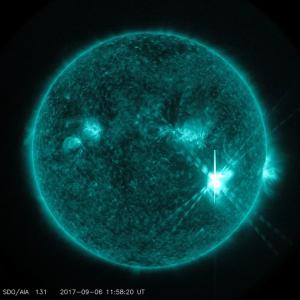
Stargazing Nights
- Where:
- Frosty Drew Observatory
- When:
- Friday September 8, 2017 at 7:30 p.m
- Cost:
- $1 Suggested Donation per Person
Tonight is Stargazing Night at Frosty Drew Observatory and the forecast is looking pretty good. We can expect clear skies all day, followed by a quick bout of partly cloudy skies just after sunset. Skies should clear nicely by 9:00 p.m., leaving fabulous views in their wake. We also have a higher than usual probability of catching a faint site of the Aurora Borealis tonight from Frosty Drew Observatory. Though the bright 94% waning gibbous Moon will substantially brighten up the sky, keeping dim objects and the Milky Way out of our view.
We will open the Observatory and Sky Theatre at 7:30 p.m. In the Observatory we will have twilight views of Saturn in the telescope followed by views of the bright gibbous Moon, Neptune, and more. In the Sky Theatre we will feature celestial objects photographed at Frosty Drew Observatory. We will stay open until 11:30 p.m.
Overall, tonight looks to be a great night if the Moon is your digs. The skies should be clear enough to catch clear views of Saturn’s rings as well as stunning views of the cratered lunar surface. We have a good chance at spotting the Northern Lights tonight which will make for a challenging view. If dark skies are your thing, then tonight is certainly one to skip, being that the Moon will blaze the sky nearly all night long. Otherwise, stop in for a sight of Saturn’s rings, the Moon and perhaps the Aurora Borealis.
-------------------
Weekly Happenings
Scott MacNeill
On Wednesday, September 6, 2017 at 8:02 a.m. EDT, sunspot group AR 2673 produced at massive X9.3 solar flare, which resulted in a large coronal mass ejection (CME) into the solar wind. Coronal mass ejections blast magnetic field and plasma from the solar corona into the solar wind. If directed at Earth, the CME’s interaction with Earth’s magnetic field and ionosphere can trigger fantastic displays of the Aurora Borealis. The resulting CME from Wednesday’s flare arrived at Earth this morning and will continue to hammer Earth’s magnetosphere and ionosphere into tonight. This will increase the likelihood of catching view of the Northern Lights over mid-latitude locations, like Southern New England. It’s important to note that these displays of the Aurora will not be massively visible as one would expect are around the Arctic Circle or high-latitude locations, and most viewers will see very faint vertical bands low on the northern horizon or a slightly increased glow-like appearance of the northern sky. Using a camera to capture the Aurora will show a better view of colors and the overall Aurora. If you want to see fabulous overhead views, you need to head into Northern New England and beyond. Regardless, step outside after late twilight tonight to a spot with a great view of the northern horizon. You just may catch a view of the Northern Lights.
This coming Friday, September 15, 2017, the NASA Cassini spacecraft, which has been in orbit around Saturn for the past 13 years, will plunge into Saturn’s atmosphere, effectively ending an amazing mission. During this final event, Cassini will pass in between Saturn’s rings and enter Saturn’s atmosphere. The spacecraft will collect information about Saturn’s atmosphere and continue to transmit as long as its thrusters can keep the spacecraft’s antenna pointed at Earth. Cassini launched on October 15, 1997 and arrived at Saturn on June 30, 2004. Since its arrival at Saturn the Cassini mission has changed our view of the ringed world and its system of Moons. Read up on some of the amazing science and discoveries that Cassini has achieved (https://saturn.jpl.nasa.gov/mission/grand-finale/why-cassini-matters/), then step outside Thursday night (September 14) during twilight and find Saturn sitting in the south sky and catch your last view of Saturn with Cassini in orbit.
-Scott


